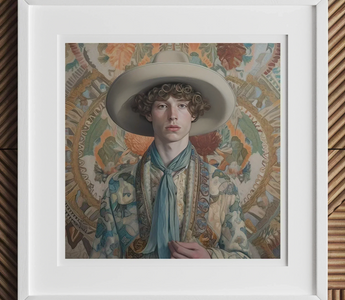A lone figure carves his silhouette against the bleeding seam of twilight—boots dust-caked, hat slung low to parry the coming night. The cowboy: America’s sculpted ideal of grit, of stoic resolve whittled down to its calloused core. Yet myth drifts like dust. And if you ride far enough beyond the picked fences of legend, you find a frontier thrumming with stranger truths.
Beneath the polished spurs and sun-split leather, queer pioneers threaded their dreams across open plains, weaving identities no Victorian parlor could confess. In the wild west of judgment’s reach, gay cowboys built lives in spite of the frontier’s savagery and because of its refusal to look too closely. They fled the cramped houses back East and rode into spaces vast enough to reimagine themselves, as feral and free as the horses they broke.
To live on the frontier was to stage a perpetual jailbreak from expectation. But stories of these queer cowboys—their stolen kisses, their renegade households, their soft rebellions stitched into saddle bags—were left to desiccate in abandoned bunkhouses, scrubbed from the marble-faced mythologies America later built.
Yet now the ground stirs. Historians, scavengers of lost rhythms, have gathered the fragments. Court records scrawled in fragile ink, anonymous ballads ash-fading at the edges, blurred photographs of men leaning tenderly toward each other in canvas tents and fireside dances. Revealing a West that was wild not only in landscape but in love. A canvas of LGBTQ identities spattered brighter and queerer than Hollywood dared imagine.
This was a frontier more raw, more alive, and infinitely more subversive than any quick-draw morality tale could capture. Beneath the open skies, gay cowboys crossed cattle trails and boundaries of gender and intimacy—sometimes hidden, sometimes warmed by firelight, always more complicated than the hero myths allowed.
Here, we’ll ride into that untamed territory: to the salt-bitter songs of cowboys who mourned their "lost pardners," to the resilience of transgender settlers who stitched new selves from frontier cloth, to the quiet ways two men could fold into each other's shadows without drawing a sheriff’s bullet or a preacher’s scorn. We’ll find the places where secrecy wasn’t shame—it was survival. And where survival meant daring to desire against the grain of empire.
The Queer West wasn’t a sidebar. It was a heartbeat, thudding steady beneath the hoofs of manifest destiny. Now it returns, guns blazing, to demand a reckoning.
Key Takeaways
- Beneath the rugged myth of the lone cowboy lies a hidden trail of queer love and gender-defying bravery, illuminated by letters, limericks, and campfire confessions—an untold frontier romance finally breaking free.
- The American West, mythologized as straight, white, and narrow, was in truth a kaleidoscope of queer identities, bachelor marriages, and transgender trailblazers who found fleeting freedom beneath endless skies.
- From gay cowboy poets mourning their "lost pardners" to transgender outlaws defying Victorian constraints, the frontier was always wild—unfenced by Eastern morals, vibrant with passion, secrecy, and subversion.
- Mythmakers may have straightened history, but buried beneath Hollywood’s veneer is an authentic West rich with queer intimacy, racial diversity, and gender fluidity—real stories of vintage gay cowboys now riding boldly into view.
- Reclaiming the queer cowboy isn’t just rediscovering history; it’s a powerful, defiant assertion of existence, reshaping the American icon into a symbol of inclusivity, resilience, and unapologetic pride.
Historical Context: Unspoken Norms of the Wild West
If the East was all corseted parlors and lace-gloved laws, the West was a skeletal draft—a rough, wide manuscript where rules barely scratched the surface of survival. By the late 19th century, the American frontier had become a scatterplot of mining encampments, dust-choked tent towns, and lonesome cattle ranches stitched thin across vast, ambivalent landscapes. Here, doctrine lost its fangs. Institutions, like rail lines and marriage licenses, came late if they came at all.
A historian once called it "a world saturated with masculinity"—and rightly so. The West’s economy ran on the muscle and mud-streaked bodies of men: loggers muscling old-growth forests into splinters, miners coughing blood in tunnels, cattle drovers whittling nights into card games and wary glances across the campfire. Gender norms arrived trailing sermons and court orders but found little traction where drought, dust storms, and snakebite dictated the terms of existence.
Out here, survival trumped surveillance. You needed a man to patch your broken ribs after a bronco stomped you flat, not to inquire about your sleeping arrangements. You needed a hand steady enough to stitch a wound or boil bad water into drinkable life—not a priest parsing your sins. Rigid moral hierarchies cracked like old leather beneath the greater urgencies of thirst, hunger, and the thin thread of breath held between one day and the next.
The farther you roamed from the territorial capitals and their parlor-watchful matriarchs, the looser the knots of Victorian propriety became. In these ad hoc communities, intimacy could flourish in the open spaces between necessity and discretion. A kind of frontier pragmatism emerged: if it kept the cattle moving and the wagons intact, affection—or something more complicated—between two men could pass without official comment.
The West wasn’t a utopia; it was a pressure valve. Every long day's ride away from Boston or Charleston loosened the corset strings of conformity another inch.
Homosocial vs. Homosexual
In the Old West, nobody spoke of homosexuals or heterosexuals. No neat taxonomy of desire. No brightly lettered flags of straight or gay pinned to shirtfronts. Those words didn’t even exist yet.
Homosexual didn't enter the lexicon until 1868. Heterosexual arrived even later, in 1924. Instead, the culture carved out a broad, rugged terrain of homosocial intimacy. Men bunked together under the stars, leaned on each other’s shoulders as the coyotes howled, shared jokes and secret griefs without the wet worry of definitions clinging to them.
he great gift of the frontier was its distraction: a thousand dangers more pressing than policing the shape of a man's affections. It was a world too busy to inventory desires. Unless those desires disrupted the flow of cattle or cash. So if the herds were kept safe, campfires lit, and love never grew loud enough to spark open scandal... no court scribbled verdicts against it.
Cowboys slept side-by-side under wool blankets slick with trail dust, swapping murmured stories and passing canteens between cracked lips. Bonds formed, thick as saddle leather, strengthened not just in confession but in the ache of endurance.
In this loose braid of survival and camaraderie, the border between friendship and romantic attachment could blur, or vanish entirely. What we now might name queer love sometimes glowed there. Wordless, assumed, buried deep beneath ritual and labor.
In the absence of women and the Victorian gender roles collapsing back East, intimacy between men became its own kind of glorified rhythm out West. Sometimes it was hidden behind coded jokes and shared tobacco. Sometimes it slow danced in a makeshift bar full of other men doing the same. So far from parlors and parlance, the difference between brotherhood and lust wasn’t just erased. They often became one and felt irrelevant at the same time.
“Strange Way of Life”: Tough, Resilient, Dependent but Roaming ‘Free’
From the flat ochres of the Kansas range to the cold pinpricks of Montana stars, the cowboy's life was stitched from both brutality and interdependence. He moved like smoke across valleys and gorges, his world stripped to essentials: a horse, a rifle, a skillet, a lonesome grin.
In this stripped-down existence, loyalty became currency. Men formed tight platoons of need—trusted each other to watch for rustlers, to yank a man from a river before the current made off with him, to stand steady when a snakebite fever came twisting through the tent walls. Partnership was not sentiment; it was architecture. The structures of survival often resembled the skeleton of intimacy.
In towns that flickered into existence between silver strikes and cattle drives, the rituals of shared survival were mistaken, sometimes willfully, for rugged fraternity. Jokes crusted with salt; songs thudded low and longing against campfire smoke. If two cowboys needed to share a bedroll, who would bother to inventory their dreams? Practicality shrugged at propriety’s trembling hands.
Freedom in the West was a paradox—liberated from one kind of structure only to be entangled in another made of cold nights and the warm necessity of another body’s proximity.
Isolation and Companionship
To live in the West was to tango with loneliness, a ragged waltz that threatened to saw a man’s mind apart. Isolation pressed down heavier than a ten-gallon hat soaked in rain. In the spaces between mountain ridges and desert flats, companionship was not a luxury—it was oxygen.
The "all-male family" was not a literary flourish but a bone-deep reality. In bunkhouses and on endless cattle drives, men formed de facto households: splitting chores, pooling meager wages, building something like a quiet domesticity out of beans, bacon grease, and late-night laughter.
Affection, when it slipped into view, often wore the plain face of necessity. No license, no church blessing, no kin gathering in stiff Sunday suits—only two men braced against winter, against loneliness, against the slow attrition of the heart.
No one asked too many questions, not when survival hinged on trust tighter than rope around a steer’s ankles.
Threats and Secrecy
But the West’s breathing room was never boundless. As railroads stitched the frontier into the body of the nation, and Protestant clerics pressed their hymnals against rough-bearded men’s chests, the old spaces of tolerance narrowed.
Starting in 1848, towns, particularly those blooming along the rails, began passing ordinances criminalizing "cross-dressing"—a legal assault aimed at pinning gender to the crossbeams of Victorian panic. Lawmen and vigilantes found new reasons to leer and judge, and for those who lived across forbidden lines of gender or love, mobility became salvation.
Cowboys and settlers who strayed from the prescribed scripts learned the delicate arts of discretion: shifting names, altering towns, blending laughter with caution. Trust was precious—and precarious. A loose tongue or an unfriendly sheriff could scatter a life faster than prairie fire.
If the frontier once allowed queer intimacy to slip through its wide, ragged seams, those seams now strained under the stitches of "civilization."
The great gamble remained: live truly and risk all, or survive in a half-shadow.
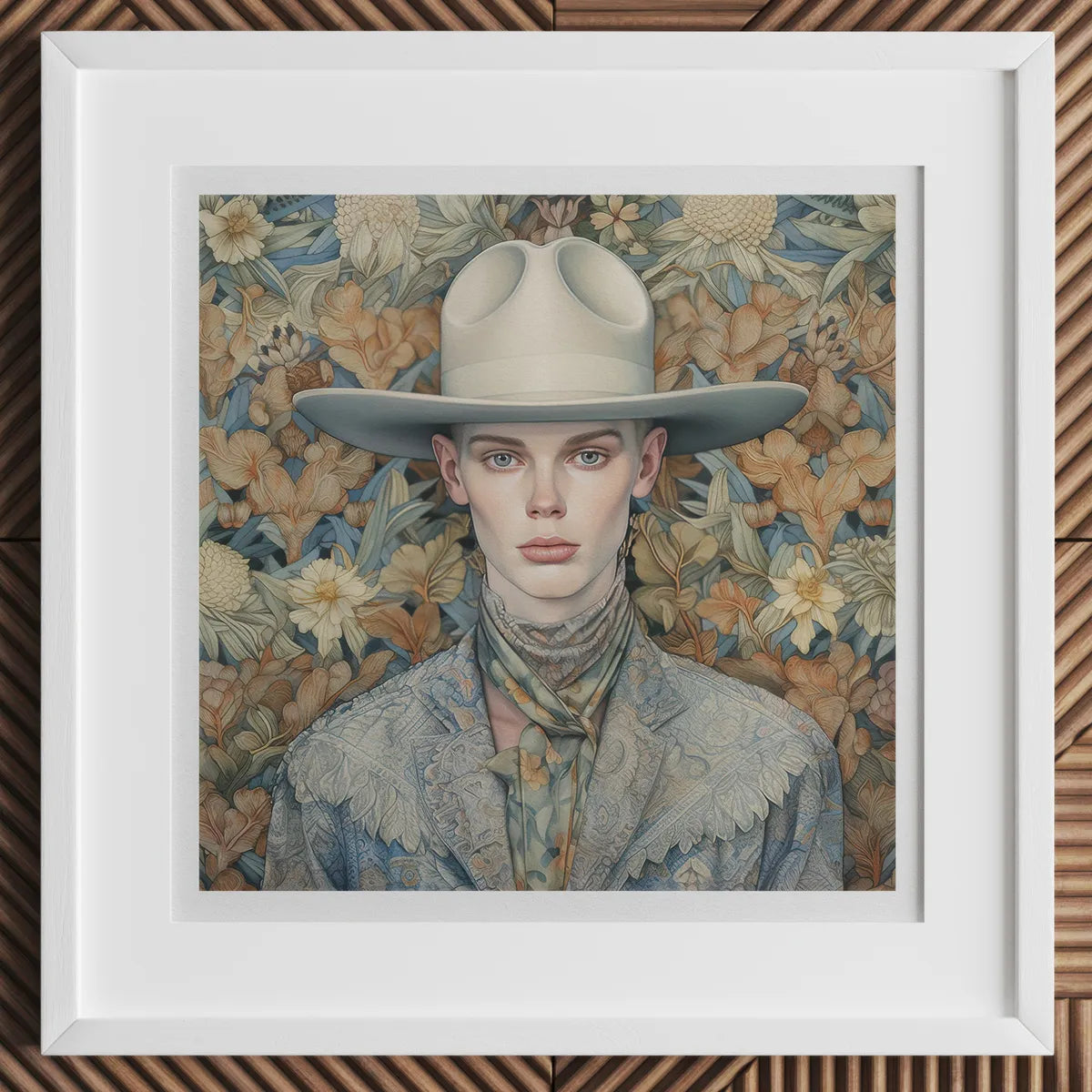
Reading Between the Ranches: Glimpses of a Queer Frontier
The West never wrote its queer stories neatly into the ledgers. Instead, they flicker at the margins: stray diary lines, bawdy campfire rhymes, half-blurred recollections leaning against the fence posts of memory. Stealth wasn't optional — it was survival’s second skin. Yet if you know where to look, the scattered breadcrumbs cohere into a rough, radiant trail.
Explicit documentation remains scarce — the wide sky favored silence over confession — but historians like Clifford Westermeier have sifted the dust for remnants. He unearthed a bawdy cowboy limerick where two men, sharing more than just kindling, became the butt and brilliance of the joke. Humor, in these cases, wasn’t mockery; it was the frontier’s camouflage — acknowledgment cloaked in jest, allowing desire to slip by unpunished so long as it didn’t shout.
In Gold Rush–era California, men outnumbered women so dramatically that intimacy and partnership between men found fertile, if unofficial, ground. A “pard” wasn’t just a pal — he might be a lifeline. Social events adapted without apology: when frontier dances unfolded, half the cowboys donned dresses stitched from curtains or old petticoats, stepping into the roles of absent women. Practical? Certainly. Playful? Often. But beneath the makeshift ribbons and laughter, deeper currents swirled. Some of those waltzing pairs spun the night into something neither camp jest nor mere necessity — something that slid, quiet and quicksilver, into real romance.
The frontier made scant room for judgment when survival stood as the higher court. Partnerships, flirtations, and affections bloomed in spaces too rugged for prying eyes — written not in manifestos, but in the subtle touch of a hand while crossing a river, or a nickname whispered across the firepit.
Little Hard Evidence, Plenty to Ponder
The documentary record remains porous, but what seeps through invites careful reckoning.
Cowboy limericks survived — laced with crude wit and longing barely disguised. Diaries crumbled into dust but captured glimpses: notes about a “pard” tending a feverish partner with a tenderness rarely extended even to kin. In the faded margins of these logs, affection thrums — not as anomaly, but as heartbeat.
Contemporary observers sometimes left clues, if not open admissions. In 1890s Denver, a professor recorded that the city’s homosexual subculture spanned many professions — ministers, teachers, even judges — and that "the usual percentage of homosexuals" could be found among university students. His observation wasn’t couched in scandal or outrage — just weary acceptance, as if noting the migration of birds.
Meanwhile, in 1911 San Francisco, an anonymous gay man penned a testament equal parts caution and awe. Life, he wrote, could be "hard but extremely interesting" — a rare, flickering self-portrait of queerness at the edge of a continent still pretending it didn’t exist.
Historians may fret over the scarcity of proof, but the frontier’s living record lay less in official archives and more in the rituals of endurance: the twin coffee mugs hung side-by-side; the shared tobacco pouches; the saddle scars rubbed into twin leather seats. Every absence from the record was itself an encoded survival.
Bachelor Marriages and Same-Sex Unions
Among the sagging porch beams and sod huts of the West, bachelor marriages stitched themselves into the everyday warp and weft of survival. These weren’t ceremonies robed in taffeta or sanctioned by church bells; they were pacts of labor, intimacy, and shelter hammered out under the iron thumb of necessity.
Two men would settle together — splitting chores, pooling earnings, nursing each other through fever and broken ribs. Communities, pragmatic to the bone, often turned a blind eye or offered quiet acceptance. As long as these partnerships kept the cattle fed, the wood chopped, and the taxes paid, sentiment mattered little to frontier eyes.
The language of partnership was often public: “my man” or “my pardner.” Displays of affection that would have wrinkled noses back East passed largely without comment if they didn’t disrupt the economy of sweat and survival.
Yet sometimes, the veil slipped — and trouble followed.
-
In 19th-century Montana, two bachelors lived together for years, until death broke the pair apart. The survivor’s raw, widow-like mourning so unsettled the townspeople that they whispered and recoiled, unsure where camaraderie ended and something "unnatural" began.
-
In New Mexico Territory in 1873, a U.S. Army post trader faced formal charges for engaging in a "most unnatural" relationship — the vague phrasing a legal cudgel when specific language was still taboo.
-
In 1896 Texas, a man named Marcelo Alviar faced a sodomy charge. His bond was set equal to that of a murderer — a stark reminder that while quiet same-sex partnerships often slipped under the radar, exposure could turn deadly in an instant.
Bachelor marriages reveal a frontier elasticity about intimacy — tolerance, until the quiet breach became too loud, too visible for Victorian comfort.
Love and Ambiguity: Cowboy Poetry and Song
If historians must lean on poetry to fill the silences of the West, they are in fine company.
Cowboy poetry flourished in the late 1800s — rough riders turning wordsmith by firelight, their verses stitched with longing, loneliness, and bonds far deeper than bunkhouse banter. Among these voices, Charles Badger Clark stands out like a scar traced lovingly by time.
"The Lost Pardner" is a poem steeped in grief so dense you can almost smell the dust of a freshly filled grave. He wrote not of battle honor or rough camaraderie, but of a loss that hollows the world: the mornings drained of color, the rides shorn of joy. His "pardner" isn’t merely a colleague — he is the axis around which the cowboy’s soul turned.
Clark’s work appeared without scandal. Readers, trained to gloss queer undercurrents into the safe pasture of "brotherhood," perhaps missed—or chose not to see—the fierce personal ache blazing beneath the stanzas.
Whether intended or not, "The Lost Pardner" now stands as a quiet, blistering anthem of queer grief on the range. In the cracks between its lines, we glimpse the shape of a love too wild to name and too real to be erased.
Beyond Cowboys – Saloons, Sailors, and the City
The Queer West galloped far beyond the dusty silhouette of the cowboy and the cattle trail’s churned dirt. It seeped into every isolated pocket of male labor: the logging camps that cleaved ancient trees from the Sierra Nevada; the railroad crews that hammered iron veins into the continent’s spine; the sailing ships that stitched coastal towns into commerce; the army outposts pitched in barren landscapes where law and longing alike twisted on the wind. Wherever men gathered beyond the reach of towns and Victorian vigilance, a rough intimacy unfurled — practical first, but seeded with something more subversive and tender.
Bachelor bonds bloomed across these outposts of hard work and harder survival. In remote lumber camps, bunkhouses crowded with men pulsed with homosocial energy: shared meals, shared jokes, shared bunks. On the rolling decks of ships, sailors packed together cheek-to-jowl, finding fleeting tenderness between voyages. Soldiers, cradled by tents and danger, formed loyalties too deep for army records to admit.
No formal language named what passed between these men; necessity had no patience for categories like “straight” or “gay.” Yet proximity braided itself into affection, and affection — often unspoken, often unwitnessed — fed the hearts that the land, the sea, and the grind of labor tried daily to hollow.
The patterns repeated, again and again. Where women were absent, intimacy between men stitched itself into the seams of daily life, sometimes unnoticed, sometimes quietly blessed by a pragmatism that cared little about the shape of desire so long as the work was done.
In California’s Gold Rush camps, with women scarce as rainfall, it became customary for men to pair off not only for economic survival but for social balance. At frontier dances, when the fiddler struck up a reel, half the men donned dresses spun hastily from spare cloth, stepping into feminine roles so the music could be honored and the night could sing. Sometimes it was play. Sometimes it was something else, glimmering in the torchlight: a fluttering, a beginning, a risk.
As the century tipped toward urbanization, queer life followed, riding the new iron rails into the rising cities of the West. By the 1890s, Denver, San Francisco, and Seattle all sheltered burgeoning queer subcultures, clandestine but vibrant. A professor in Denver noted with offhand precision that homosexual men could be found across the professional spectrum — ministers, judges, teachers, students — a mundane observation that spoke volumes about the breadth and quiet persistence of queer life even under the moralistic gaze of Victorian expansionism.
In these frontier cities, a parallel society quickened in boarding houses, alleyway saloons, and boarding-school whispers. Men who had lived as pards on the cattle trails or bunkmates in the mining camps found echoes of those old intimacies in new taverns and rented rooms. Though newspapers often cloaked these existences in euphemism or lurid scandal, the truth shimmered beneath: the Queer West had not faded with the cattle drives; it adapted, flowering through the cities like wild columbine through abandoned wagon tracks.
Later, the sex researcher Alfred Kinsey would uncover an unexpected reverberation of these frontier patterns. In his 1948 study, Kinsey found that some of the highest rates of homosexual intimacy occurred not in bustling metropolises, but in rural farming communities — descendants, perhaps, of those early frontier attitudes where scarcity, isolation, and survival blurred the lines that cities would later demand be drawn in ink.
The Queer West's legacy stretched beyond cowboys and cattle trails into the Great Depression’s farmhands and the rail-hopping drifters of the Dust Bowl. Everywhere that hard labor pushed men together and forced them to rely on each other more than on distant laws or absent churches, the old ways flickered back into life: partnerships forged from necessity but nourished by something warmer, quieter, and infinitely harder to erase.
In truth, the frontier’s rough gospel of survival had always carved space—hidden, mutable, tenacious—for queer lives to endure. Not through the blessing of tolerance, but through the shrugging pragmatism of a world too busy surviving to enforce distant morals with any real vigilance.
Even when the cities rose and the churches built higher steeples, even when the courts issued stricter laws and the dime novels straightened every cowboy’s back into rigid heterosexuality, the truth rode on: whispered in boarding houses, etched in bunkhouse walls, stitched into the bodies of men who had once danced in borrowed skirts beneath the open stars.
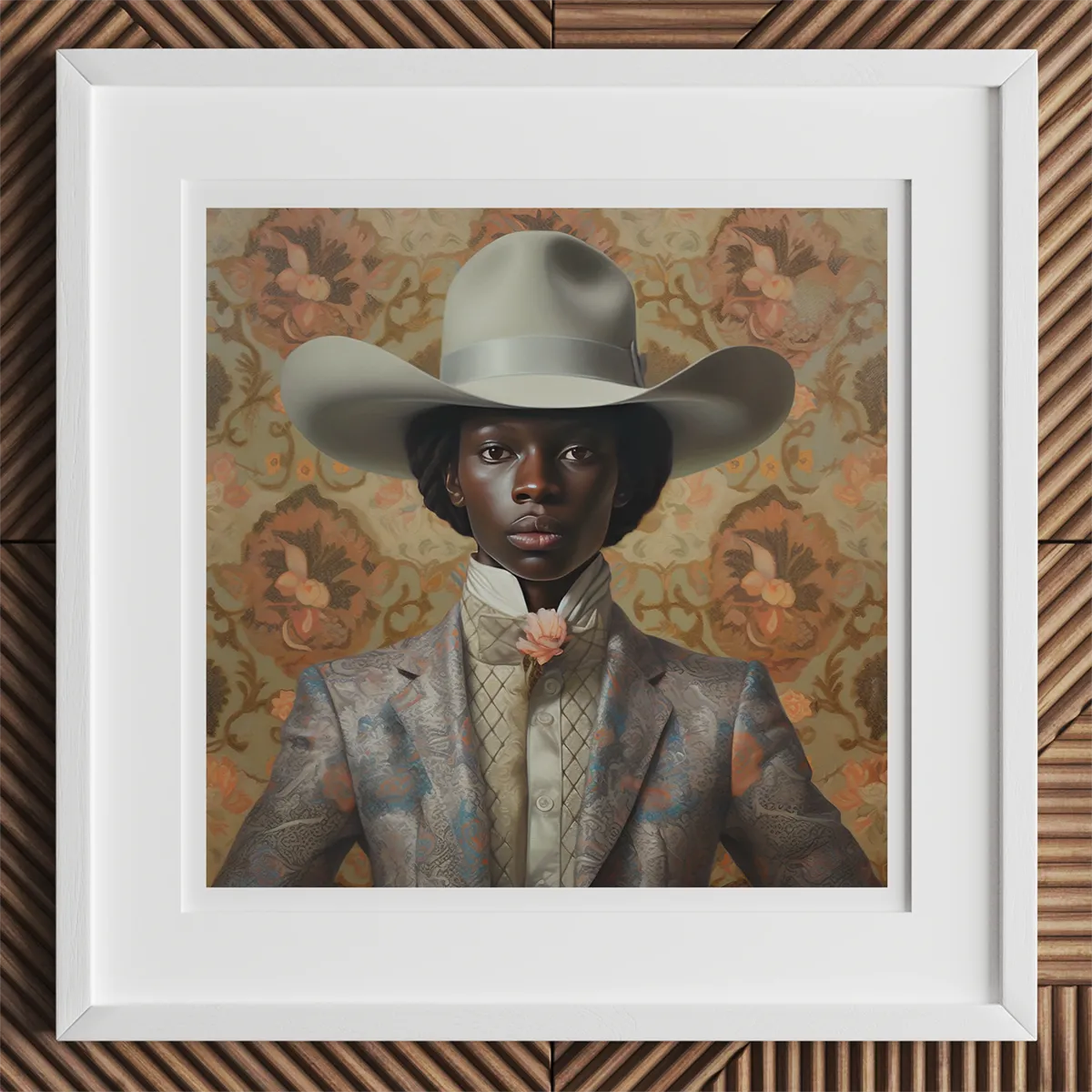
Queer Pioneers and Outlaw Tales from the Old West
To truly humanize this history, let’s meet some famous gay cowboys – individuals whose stories give us windows into the Queer West though fragmentary records and plenty of intrigue. And these famous gay cowboy names range from poets and lawmen to outlaws and aristocrats, painting a picture as diverse as the West itself.
The Cowboy Poet and His “Lost Pardner”
Charles Badger Clark Jr. never fit the starched frontier myth—he split its seams. Born 1 January 1883 in Albia, Iowa, he trailed his Methodist-minister father through the raw Dakota Territory, from Huron’s plank-side chapels to Deadwood’s saloons. Rev. Clark preached over Calamity Jane’s coffin; Badger skipped Dakota Wesleyan after a fistful of ideologic sparks with a founder. Tuberculosis stalked the family—mother Mary and brother Frederick gone by 1901—so the restless son bolted south.
Cuba, 1904: a botched coconut theft, gunfire, two weeks on a brick jail floor with seventeen men. He scraped Spanish off the walls and smuggled it home in his throat. By 1905 Tombstone’s dry air eased his own TB, and four years managing an isolated Arizona spread salted his verses with saddle vernacular and phonetic swing. Stepmother Anna mailed “In Arizony” (later “Ridin’”) to The Pacific Monthly—ten dollars, a door kicked open.
Then, 1895’s earlier ache resurfaced: “The Lost Pardner,” a hymn for his fallen companion Al. “We loved each other in the way men do / And never spoke about it, Al and me,” he confesses; “knowin’ it so true / Was more than any woman’s kiss could be.” The knee brushing his on twilight rides, the hush of joint bivouacs—Clark inks a grief frontier daylight could not name, a queer devotion hidden beneath trail-dust stoicism yet ringing, unashamed, through every line.
Back in South Dakota (1910), he nursed his ailing father, then settled into a roofless theology of solitude: the Badger Hole cabin in Custer State Park, thirty winters without plumbing, hauling Galena Creek water in tin pails. Governor Leslie Jensen christened him South Dakota’s first Poet Laureate—“poet lariat,” Clark joked—in 1937. Grass-Grown Tales (1917), “A Cowboy’s Prayer,” and the border-spiced “Spanish Is the Loving Tongue” galloped across Sunset, Scribner’s, Collier’s, and eventually the voices of Pete Seeger and Bob Dylan. Composer Gertrude Ross cradled his words in “Roundup Lullaby”; the Fred Waring Chorus intoned “Lead My America” in 1957.
Twice engaged, forever bachelor, he claimed $500 a year and debt-free living beat any conjugal compromise. He lectured from women’s clubs to the Redpath Chautauqua circuit, yet always rode home to silence and stacked firewood. Throat and lung cancer stilled him 26 September 1957 in Rapid City; Evergreen Cemetery holds his bones, while the National Cowboy & Western Heritage Museum inducted him, posthumous saddle-horn high, in 1989.
Today, historians reread Clark not as mere cowboy laureate but as a quiet sentinel of the Queer West—proof that same-sex love breathed beneath buffalo grass and church bells alike, leaving poems for evidence where language and law once refused confession.
The Lost Pardner, Charles Badger Clark
I ride alone and hate the boys I meet.
Today, some way, their laughin' hurts me so.
I hate the mockin'-birds in the mesquite—
And yet I liked 'em just a week ago.
I hate the steady sun that glares, and glares!
The bird songs make me sore.
I seem the only thing on earth that cares
'Cause Al ain't here no more!
'Twas just a stumblin' hawse, a tangled spur--
And, when I raised him up so limp and weak,
One look before his eyes begun to blur
And then—the blood that wouldn't let 'im speak!
And him so strong, and yet so quick he died,
And after year on year
When we had always trailed it side by side,
He went—and left me here!
We loved each other in the way men do
And never spoke about it, Al and me,
But we both knowed, and knowin' it so true
Was more than any woman's kiss could be.
We knowed—and if the way was smooth or rough,
The weather shine or pour,
While I had him the rest seemed good enough—
But he ain't here no more!
What is there out beyond the last divide?
Seems like that country must be cold and dim.
He'd miss the sunny range he used to ride,
And he'd miss me, the same as I do him.
It's no use thinkin'—all I'd think or say
Could never make it clear.
Out that dim trail that only leads one way
He's gone—and left me here!
The range is empty and the trails are blind,
And I don't seem but half myself today.
I wait to hear him ridin' up behind
And feel his knee rub mine the good old way
He's dead—and what that means no man kin tell.
Some call it "gone before."
Where? I don't know, but God! I know so well
That he ain't here no more!
Sir William Drummond Stewart’s Wild Adventures
Sir William Drummond Stewart did not gallop west so much as slip its bridle, arriving in St Louis in 1832 with letters for William Clark, Pierre Chouteau Jr., and William Ashley—calling cards for a continent still inventing itself.
By summer 1833 he was riding Robert Campbell’s pack train toward the Horse Creek Rendezvous, Green River Valley. The Scottish baronet cut a figure: cool shot, level-headed expedition manager, able huntsman. He prowled the Big Horns, wintered in Taos, drifted to Fort Vancouver, his purse sometimes thin because an errant brother withheld inheritance. So he speculated in cotton down in New Orleans, thawed in Cuba, then turned his horse back to Wyoming for one more rendezvous, cash still unsettled but pulse unwavering.
There, amid pelts and powder, he met Antoine Clement—French-Cree hunter with eyes like struck flint. Their intimacy stretched nearly a decade. Stewart’s androgynous velvet, Clement’s sinew and silence: bodies speaking where language failed. When the baronet inherited Murthly in 1838, he ferried Clement to Scotland, installed him at Dalpowie Lodge—first as valet, later footman—before restlessness drove them east to the deserts and, eventually, west again.
September 1843: Fremont Lake shimmered beneath a Renaissance fever. Stewart, co-hosting with trader William Sublette, dressed every man in silk and velvet, knights and jesters gleaming beside rawhide tents. He financed the pageant by selling Logiealmond Castle; rumors later called it “a big, gay, medieval-themed orgy.” Camp tensions curdled into scandal; by the time the party limped back to St Louis, Stewart bolted for Europe, never to return. Clement faded—drink, exile, oblivion.
Yet the paintings endure. Alfred Jacob Miller’s oils—commissioned in 1837, delivered to Dalpowie in 1839—render rendezvous heat, mountain chiaroscuro, the baronet’s arm draped over his hunter. Historians now read those canvases, and William Benemann’s Men in Eden, for the “deliciously free and wild—and gay” marrow of frontier life. Benemann scoured Murthly archives, stitched lost letters, and tethered Stewart’s saga to modern heartbreaks like Matthew Shepard’s—proof that queer history resists bullet holes and bad faith alike.
So remember the masquerade armor clanking against beaded buckskin, the cotton-speculator’s ledger stained with creek-water, the baronet and his lover sharing a bedroll beneath Wyoming stars. In that untamed grammar—before labels, before fences—freedom meant a hand lingering a heartbeat longer than custom allowed, and no sheriff on earth could name the crime.
Outlaw of Love: The Bisexual Bandit
Bill Miner, the Bisexual Bandit Who Robbed by Rail and by Heart
The frontier’s ledger tallied more than cattle rustled and safes blown. It logged bodies and desires that refused polite categorization. Consider two outlaws who bucked every rule the territories tried to brand on them...
Bill Miner began with stagecoaches too, then graduated to passenger trains, carrying a revolver and a reputation for amorous elasticity. After his 1903 holdup outside Portland, Pinkerton’s National Detective Agency issued what one historian calls the first public outing of Miner’s bisexuality: a reward circular warning he “is said to be a sodomist and may have a boy with him.”
The crude slur was meant to scandalize, yet it inadvertently sketched the shadow map of queer networks the law could not chart. Years in San Quentin seasoned Miner’s craft and widened his circle; upon release, young male cell-mates followed him into fresh capers—love and larceny sharing the same saddlebag.
Miner reminds us the Wild West’s real untamed terrain was identity itself. A bisexual robber slipping jail bars with accomplices who doubled as lovers. Carving room for queerness in a landscape supposedly policed by Victorian virtue.
Railroads laid tracks, sheriffs fired rounds, Pinkertons filed dossiers, but desire still galloped beside every coach, curled behind every saloon door, and thundered across prairie nights unbridled, unbowed, and gloriously unclassified.
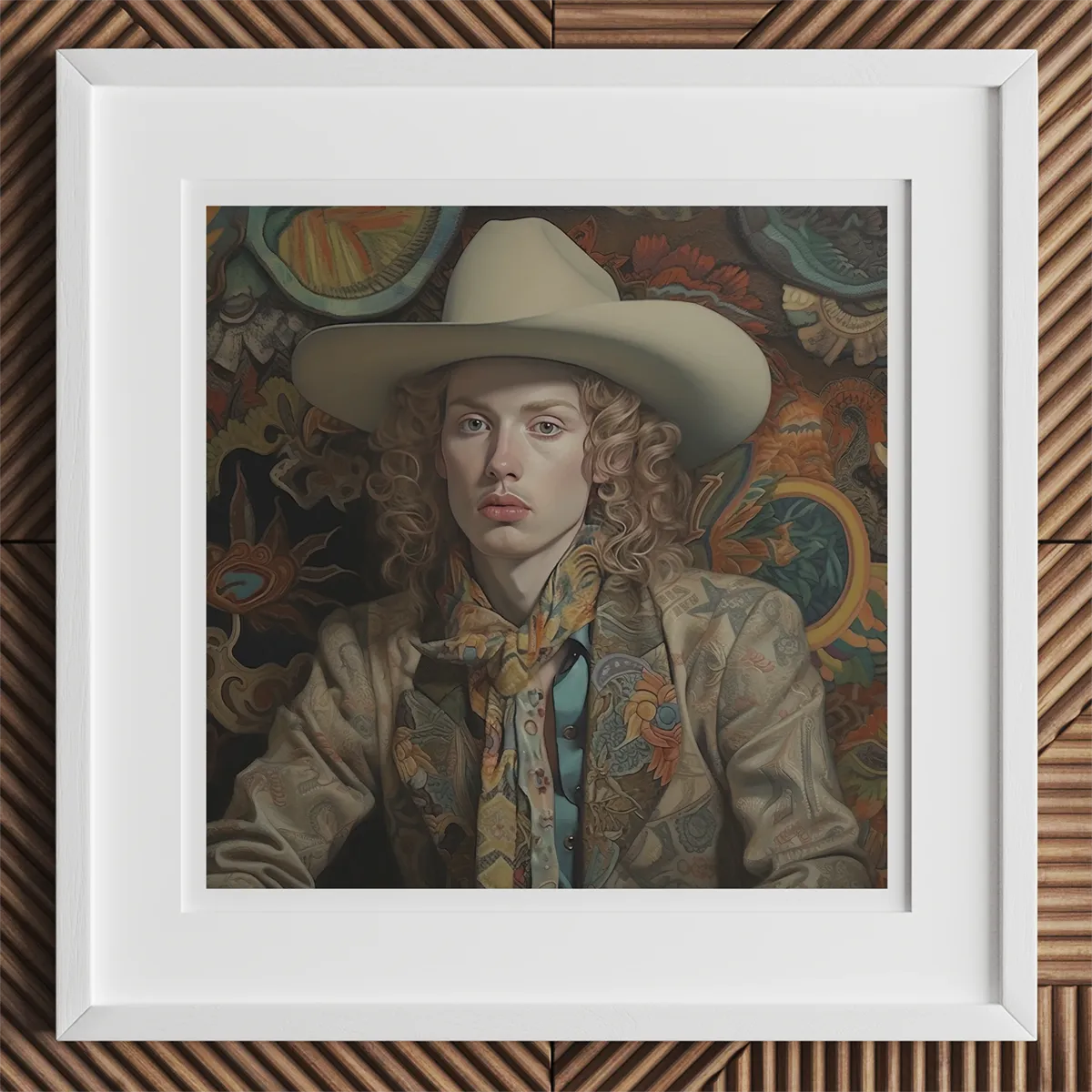
Gender Non-Conformists of the Frontier: Trans Cowboys and Cross-Dressing Outlaws
The Wild West also served as a stage for those who dared to live as another gender. Sometimes it was for survival or economic opportunity, sometimes for love – often a mix of all three.
Charley Parkhurst
Charley “One-Eyed” Parkhurst could make a six-horse hitch dance along the cliff-edges of the Santa Cruz Mountains, reins flicking like a violinist’s bow. Born an orphan in 1812, assigned female, he stepped into boy’s boots early and never looked back.
By daylight he cracked a whip so clean it once felled the bandit Sugarfoot mid-heist; by lantern glow he patched axles, shot varmints, and spat tobacco with the best of them—one glass eye glinting from a mishap while shoeing a restless mare. When a coach rollover “busted in her sides,” Charley waved off the doctor, cinched his belt, and drove the next run anyway.
Election Day 1868 found him at the polls, a ballot sliding from leathered fingers half a century before women’s suffrage—proof that gender could outride statute when nerve held the reins. Pay packets fattened his purse; tales of his marksmanship fattened legend. Behind saloon doors nobody questioned why this wiry driver locked his room alone, or how a hidden pregnancy once passed beneath buckskin layers—only later did neighbors discover the baby dress folded among his effects.
Death, 1879: undertakers peeled back the disguise, and newspapers gasped about a “hermaphrodite” who had fooled them all. Yet respect stuck; even the San Francisco Call conceded the feat of “successful concealment for protracted periods of the female sex.”
Historians now name him a transgender man avant la lettre, a renegade of self-definition who steered not just Concord coaches but the frontier’s idea of what a man could be. Peter Boag places Parkhurst among the hardy entrepreneurs whose male guise unlocked wages and safety—not mere masquerade but existential statement—while noting how society praised such cross-dressers’ grit even as it scorned their male-to-female counterparts.
Television later tried to harness the tale: Death Valley Days (1958) cast Frank Gerstle in Charley’s seat, glossing the texture but keeping the thrill. Still, the real legacy rattles down every rutted canyon road—proof that the Wild West’s sharpest turns were navigated by outsiders who refused the era’s narrow lanes, reins taut, eye fixed on a horizon only they could see.
Sammy Williams
Sammy Williams swung a double-bit axe like punctuation—each blow a full stop against the frozen ponderosa.
Short, hunched and smooth-cheeked, he smoked, chewed, cursed, and flirted through two raw Montana decades. Logging by day and cooking beans for the same crew at night. To his bunkhouse brothers he was simply “one of the guys”—and, they joked, a “great ladies’ man.”
Why the disguise? Money, pure and simple. Peter Boag reminds us that a woman scrubbing shirts earned half what a sawyer made; swap trousers for skirts and the pay vanished. So Sammy chose the heavier wage, the heavier tools. When a rolling log dislocated his shoulder and the doctor reached for chloroform, Sammy clenched his teeth—mindful that unconsciousness could expose the secret buried beneath flannel.
December 1908, Manhattan, Montana: eighty winters etched in bone finally snapped. As the undertaker prepared Williams' body, the town learned Sammy had been assigned female at birth. Stunned campmates passed the hat for his burial; a neat life-insurance policy and unexpected property hinted at careful planning behind the rough exterior. Their tombstone still bears his chosen name—his birthplace, real age, and given gender lost to the pine-scented wind.
Williams’s story distills the frontier’s brutal arithmetic: skill plus endurance equaled belonging. On that ledger, gender was tallied only in board-feet felled and meals served hot. An unsentimental calculus that carved quiet room for lives Eastern sermons would have damned on sight.
Harry Allen
Harry Allen carved through the Pacific Northwest like a whetstone—sharpening every frontier myth until it bled.
Born Nell Pickerell in Indiana, 1882, he hit Seattle’s muddy plank-roads by 1894 and, before his voice had even settled into its rich baritone, traded dresses for denim and rechristened himself Harry Livingston. “I did not like to be a girl,” he told The Seattle Sunday Times in 1908. “So I made myself a man.” Police files soon dirtied that surname, so he shed it for Allen and kept moving.
Allen’s résumé read like a dime-novel gauntlet: bronco buster on high desert ranches, longshoreman loading Puget cargo, bartender, barber, boxing second, hotel clerk—every job a pay grade barred to women. He rode hard, drank harder, and courted women with such swagger that reporters dubbed him a “lady killer.”
Seattle and Spokane papers feasted on every arrest—vagrancy, disorderly conduct, “white slavery” in 1912 when he crossed state lines with partner Isabelle Maxwell, a sex worker posing as his wife.
No statute banned cross-dressing, so police stretched catch-all laws, sometimes locking him up until he donned skirts—an ultimatum he met with stone refusal. And yet, by decade’s end they were quietly paying him as an informant against bootleggers, proof that usefulness could outmuscle prejudice.
Behind the headlines, Allen hustled for survival in a world that demanded paperwork for every deviation. Historians like Peter Boag now read his “criminal record” as a ledger of discrimination: each charge a semaphore of society’s panic as Western boomtowns imported Eastern moral codes.
Living openly as a man gave Allen wider wages and wider horizons, but also a magnified target. Still, he outlasted most of his tormentors, dying in Seattle, December 27, 1922, of syphilitic meningitis at forty. Papers recorded the passing of a “notorious character”; Boag and later scholars record something larger. The stubborn fact that transgender lives were already pulsing through saloons and stockyards well before language found them.
Allen’s story, messy and magnetic, folds neatly into the frontier’s ledger of necessity: talent plus daring equaled a kind of conditional latitude. He wrangled broncos, whiskey, and headlines, exposing how gender’s so-called boundaries were just fence posts waiting to be kicked loose by any rider bold enough to lean into the gallop.
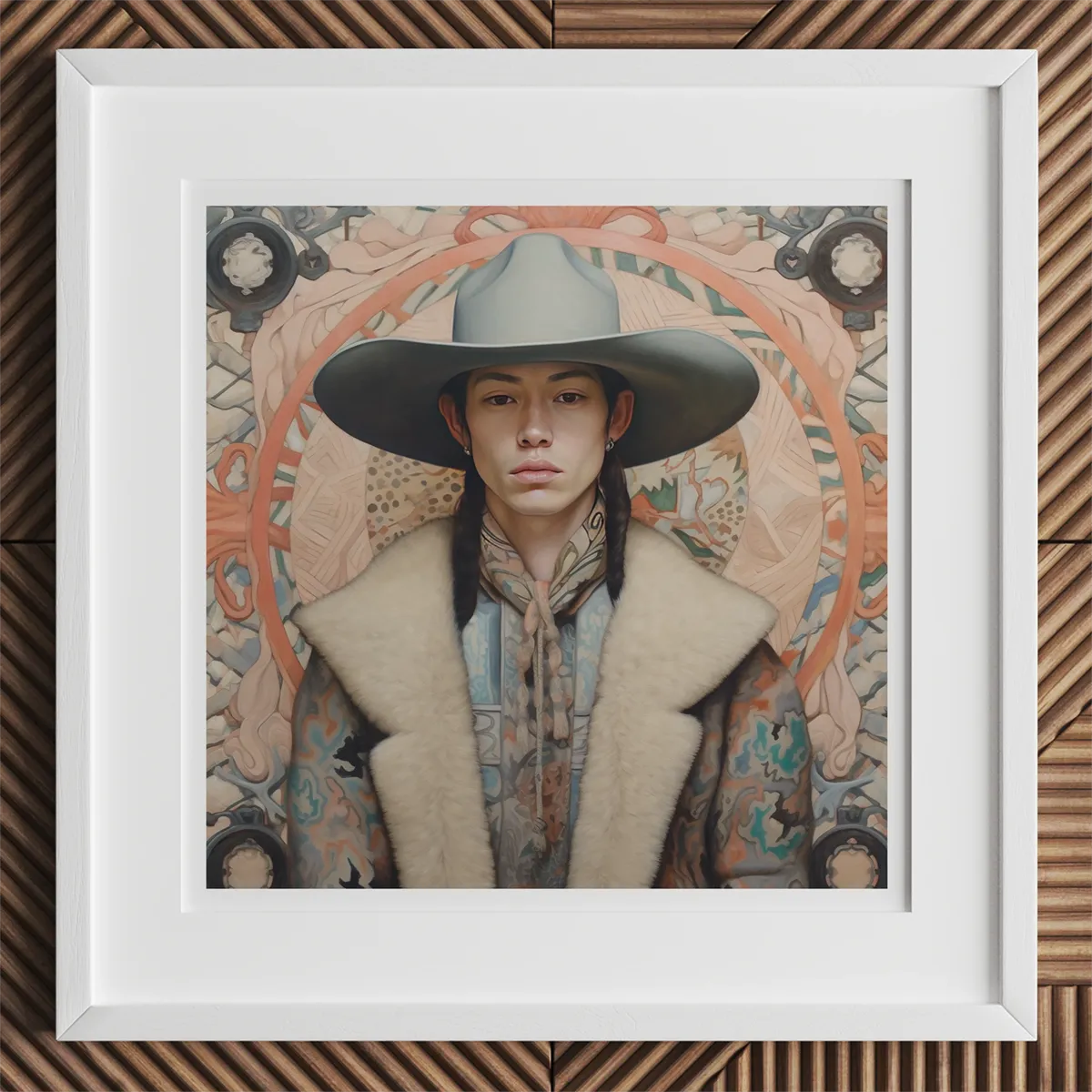
Myth of the Straight, White Cowboy & Erasure of the True Wild West
If queer cowboys and non-white cowboys were so common, why do popular images still default to the straight, white Marlboro Man? The answer lies in how the West was later mythologized—in dime novels, Wild West shows, and especially Hollywood. 20th-century storytellers deliberately created a mythic cowboy archetype to serve American ideals, excluding inconvenient truths about diversity.
The “Lone” Cowboy
The cowboy, that brooding silhouette cut against the blood-orange sunset, did not emerge from the open plains whole-cloth. He was sculpted — painstakingly, deliberately — by mythmakers who wanted him to carry not just saddlebags but ideologies.
In the dime novels of the late 19th century and the celluloid reels of early Hollywood, the cowboy became a "lone" figure: grim, isolated, a self-reliant sentinel riding across an unpeopled wilderness. He needed no companions, no entanglements. His heart, like his six-shooter, pointed straight and unerring.
But this vision was a polished lie, a fantasy tailored to nourish emerging American ideals of rugged individualism. In truth, the frontier cowboy lived cheek-to-jowl with his peers — swapping jokes, supplies, warmth, and sometimes tenderness. Real cowboys moved in crews, bunked together in cramped quarters, and formed bonds of necessity so profound they often blurred into affection.
The myth scrubbed these realities clean, wary that close male partnerships might suggest something less tidy than the narrative demanded. Emotional interdependence, vital on the trail, became invisible in fiction. Where two cowboys once shared a bedroll against the cold, Hollywood left one riding alone into an antiseptic sunset.
Whitewashing the Range
Hand-in-hand with this erasure of emotional complexity came a ruthless bleaching of racial truth.
The cowboy was recast in films and novels as an Anglo-Saxon hero taming a wild, empty land — never mind that the land was neither empty nor tame. The actual West teemed with Indigenous nations, Mexican vaqueros, Chinese railroad workers, and African American freedmen carving lives from harsh soil.
Historical records reveal that one in four cowboys was Black — a statistic that staggers against the alabaster tide of cinematic cowboys played by actors like John Wayne. Countless more were Mexican or Indigenous, inheritors of centuries-old traditions of horse mastery, cattle herding, and land stewardship that predated the American frontier myth altogether.
This deliberate whitewashing sanitized conquest, turning genocide and cultural theft into a pageant of white grit. It erased not only the diverse realities of those who built the West but also buried the fluid, unruly intimacies that thrived among them.
Where the real frontier was brown and black and wild with unexpected kinships, the myth forged a clean, white, heterosexual figure — a moral mascot for Manifest Destiny.
African-American Cowboys
In the scorched aftermath of the Civil War, many newly freed African Americans looked westward, seeking the kind of freedom Reconstruction too often denied. They found it, sometimes, in the saddle.
Figures like Nat “Deadwood Dick” Love rose to near-mythic stature, his autobiography detailing a life spent wrangling cattle, busting broncos, and surviving gunfights not as a novelty but as a peer among peers. On the frontier, Love often found that skill outshone skin color — at least until towns grew large enough for Jim Crow’s iron hands to catch up.
Another titan was Bill Pickett, a Black cowboy who pioneered the rodeo sport of bulldogging — the act of wrestling steers to the ground by biting their lips, a technique he developed from observing cattle dogs at work. His fame eventually earned him a place as the first African American inducted into the National Rodeo Hall of Fame.
Yet for all their contributions, men like Love and Pickett were erased from the collective imagination, their saddles left empty in the history books. Hollywood’s Westerns did not ride with them. Textbooks rode past them. Only now do their stories reemerge, kicking down the corral fences of myth.
Indigenous Cowboys: The Two-Spirit Horsemen
If Black cowboys were pushed from the frame, Indigenous cowboys were rendered almost invisible — or else villainized.
Yet Native Americans, particularly Plains tribes like the Comanche, had long been expert horsemen before the frontier’s mythology had even drawn its first breath. As cattle ranching expanded westward, many Indigenous men became indispensable as scouts, herders, and wranglers.
Within these communities, traditions also existed that honored gender fluidity — identities we might now recognize as Two-Spirit. In cultures from the Lakota to the Navajo, individuals who blended masculine and feminine roles were often granted unique spiritual and social positions. Some Two-Spirit people lived openly among their tribes, embodying multiple roles across gendered divisions that colonial societies sought to harden.
This Indigenous flexibility around gender and sexuality likely influenced the broader ethos of the early frontier: a tacit tolerance born from practical need and older cosmologies that respected variance.
But with settler expansion came violent suppression. Two-Spirit traditions were targeted for erasure alongside language, ceremony, and land. What had once flourished in harmony with the earth was hunted to the margins, rendered nearly invisible by the twin engines of church and state.
Yet the tracks remain — if you know where to ride, if you listen closely to the old songs.
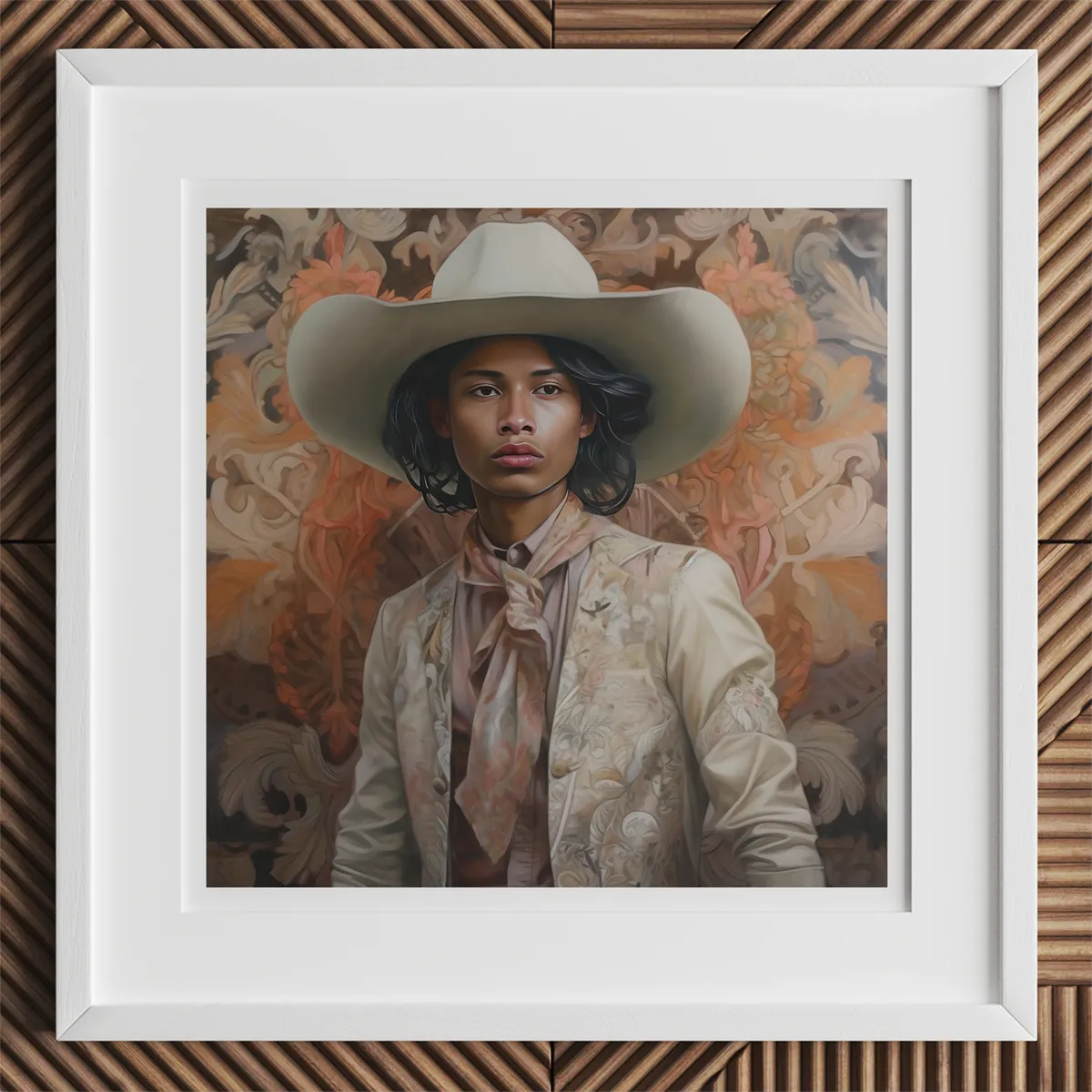 Beyond Brokeback: Reclaiming the Cowboy in Modern Times
Beyond Brokeback: Reclaiming the Cowboy in Modern Times
In 2005, Brokeback Mountain tore a hole in the mythic fabric of the West and let the forgotten ghosts howl back through. Annie Proulx’s short story was already canon in the slimline history of books about gay cowboys. And the wrenching cinematic adaptation by Ang Lee dared to stitch two men into the rugged tapestry of cowboy life not as a punchline or tragic afterthought, but as the aching, beating heart of the frontier’s most sacred archetype.
This gay western love story of Jack Twist and Ennis Del Mar was slow-blooming and devastating. Unsettling many audience members because it struck too close to the myths America had learned to cradle like a worn Bible. The cowboy, that untouchable icon of stoic masculinity, was shown with his heart laid bare — bruised, yearning, and profoundly queer.
Some critics raged, as if sacred ground had been defiled. Yet the queer western's resonance only served to underscore what the myth had worked so hard to bury: that the West was never the hermetically sealed, heterosexual stage show it was sold as. Brokeback did not invent queerness in cowboy culture; it pulled aside the curtain to reveal what had been thundering quietly underneath for centuries — the secret histories of written in folded letters, stolen glances, and abandoned ranch houses.
The International Gay Rodeo Association: A New Frontier
Long before Brokeback Mountain flickered across movie screens, queer cowboys were already wrangling their own traditions back into daylight.
By the 1970s, a grassroots movement coalesced around rodeo events where LGBTQ riders could buck bulls, barrel race, and lasso goats free from the stiff judgment of traditional circuits. The first major event, the National Reno Gay Rodeo, galloped into life — raising funds for charity and creating sanctuary at a time when AIDS was ravaging the community and mainstream acceptance remained a distant mirage.
In 1985, various regional rodeos united under the International Gay Rodeo Association (IGRA), formalizing a network that still rides strong today. Unlike traditional rodeos with rigid gender divisions, IGRA events were — and are — gleefully subversive. Men and women compete across categories, drag performers sashay through the arena, and events like "goat dressing" blend humor with athletic prowess.
Under the dust and spectacle lies something deeper: a reclamation of Western identity, an insistence that the cowboy’s courage was never contingent on who he loved or how she dressed. The gay rodeo stakes a stubborn, joyous claim to a heritage too often weaponized against its own children.
Cowboys as Icons in LGBTQ Culture
The cowboy — once scrubbed of tenderness, color, and complexity — has become an unlikely phoenix in queer iconography.
In the 1970s and '80s, the cowboy’s broad shoulders and denim swagger were reappropriated into a symbol of queer bravado. The Village People danced it onto disco floors; Tom of Finland inked it into erotic mythos, his cowboys towering with exaggerated masculinity, mustaches glinting like sabers.
The aesthetic wasn’t merely camp. It was a subversion — a re-forging of the cowboy mythos into something that held pride rather than exclusion. Rough, rural manhood, once wielded as a cudgel against queerness, was remade as armor, as celebration, as seduction.
And it wasn’t limited to men. Lesbian ranchers, drag kings, and transgender rodeo stars found fertile ground in the cowboy myth too — drawing not only on its visual power but on its deeper spirit: resilience, reinvention, defiance of constraint. They became inheritors of a tradition much older than Hollywood’s narrow scripts, kin to the frontier women who shouldered rifles and rode horses in men’s boots long before permission was granted.
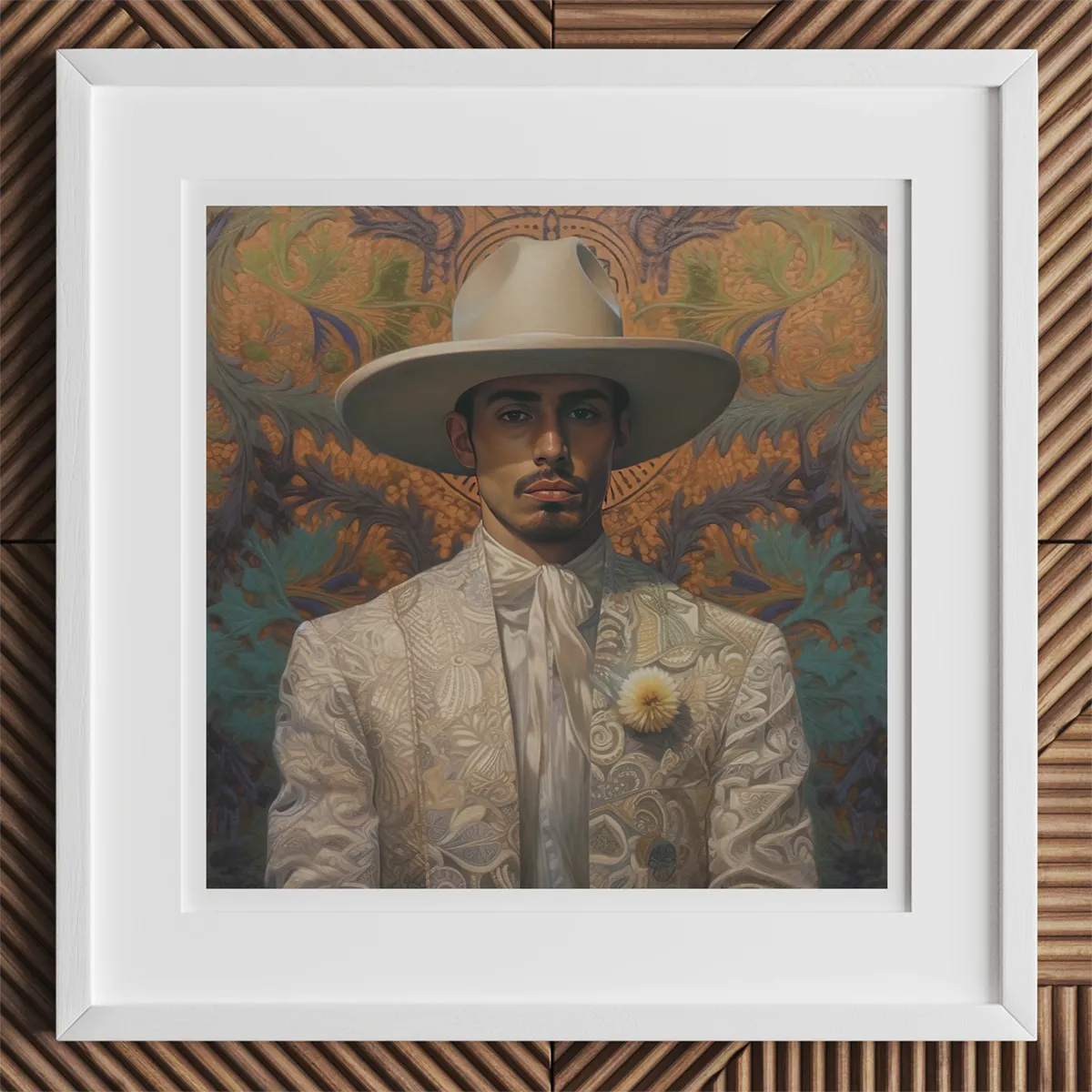
A More Inclusive Western Mythos
Today, the Western mythos is being not merely critiqued but rebuilt — plank by plank, song by song, frame by frame.
Academics, filmmakers, and artists are unearthing the layered, messy truths of frontier life and refusing to return them to shallow graves.
-
Films like The Power of the Dog explore the poisoned legacies of closeted life under the wide skies.
-
Documentaries and photo exhibitions spotlight queer rodeo athletes, tracing the modern echoes of those old hidden partnerships.
-
Novelists weave queer Western romances that refuse tragedy as the only ending.
This is not invention; it is restoration. A bringing-to-light of what was always there, obscured by the self-serving myths of empire and morality. The cowboy is no longer confined to whiteness, maleness, heterosexuality. He — or she, or they — now rides with the full complexity, pain, grit, and beauty that the true frontier always demanded.
For rural queer youth, the revised Western saga becomes a mirror where none existed before — a way to see themselves not as exiles from their communities but as part of an ancient, stubborn lineage of those who lived fiercely under open skies.
This is the frontier reimagined not as a sanitized origin myth but as a living, breathing archive — one whose stories are still being written in dust and blood and starlight.
Riding Proud into the Sunset
The queer West is no mirage, no retroactive invention etched wistfully onto the landscape. It is history — sun-seared and bloodstained — humming underfoot like the low vibration of distant thunder. And to ride into its truths is not merely to correct the ledger of the past, but to resurrect entire lives once buried under the sand-drifted myths of rugged, solitary men.
At one level, this reclamation is about archival justice: combing through brittle court records, yellowed diaries, and offhand newspaper references to find the traces of gay cowboys, transgender ranchers, and queer outlaws who refused to conform even when conformity came armored with violence. Their existence demands that we unlearn the Hollywood lies — that we recognize the cowboy not as a singular straight white titan but as a tangled braid of identities, hopes, and loves.
But it is also more than scholarship. It is an act of spiritual continuity.
Figures like Charles Badger Clark, singing grief for a lost pardner into the cold prairie wind; Sir William Drummond Stewart, staging medieval masques of love and liberty along Fremont Lake; Harry Allen, swaggering in defiance across saloon thresholds — these individuals didn’t just survive the frontier. They reshaped it from within, daring to live lives unshackled by the narrow prescriptions of gender and sexuality.
Their breath is still in the dust.
Today, to claim the cowboy — queer, trans, Black, brown, Indigenous, defiant — is an act of defiance wrapped in patriotism. It says: We were here, building your towns, roping your steers, riding your storm-tossed landscapes long before you wrote us out of your storybooks.
It says: The frontier was never a straight line. It was always a crossroads.
As scholarship deepens, as films and exhibitions widen the horizon, the cowboy is no longer the monolith of Western exceptionalism. He is, at last, a multitude — riding proud beneath skies as plural and unpredictable as the human heart itself.
Each time a gay rodeo rider hoists a trophy, a trans rancher rebuilds a fence-line, or a poet spins old Western rhythms into new songs of resilience, another plank is laid in the bridge back to truth. The frontier never belonged to one kind of soul. It was — and remains — a wild, untamable testament to all the ways human beings insist on becoming themselves against every gate and every gun.
To see the Queer West fully is to understand that it never needed permission to exist.
It only needed someone — someone like us — to look back across the dust and say:
You were always here.
You were always riding with us.
And we are still riding, together, into the fire-lit dusk.
For Lazy Nerds and Visual Learners
Gay Cowboys On YouTube

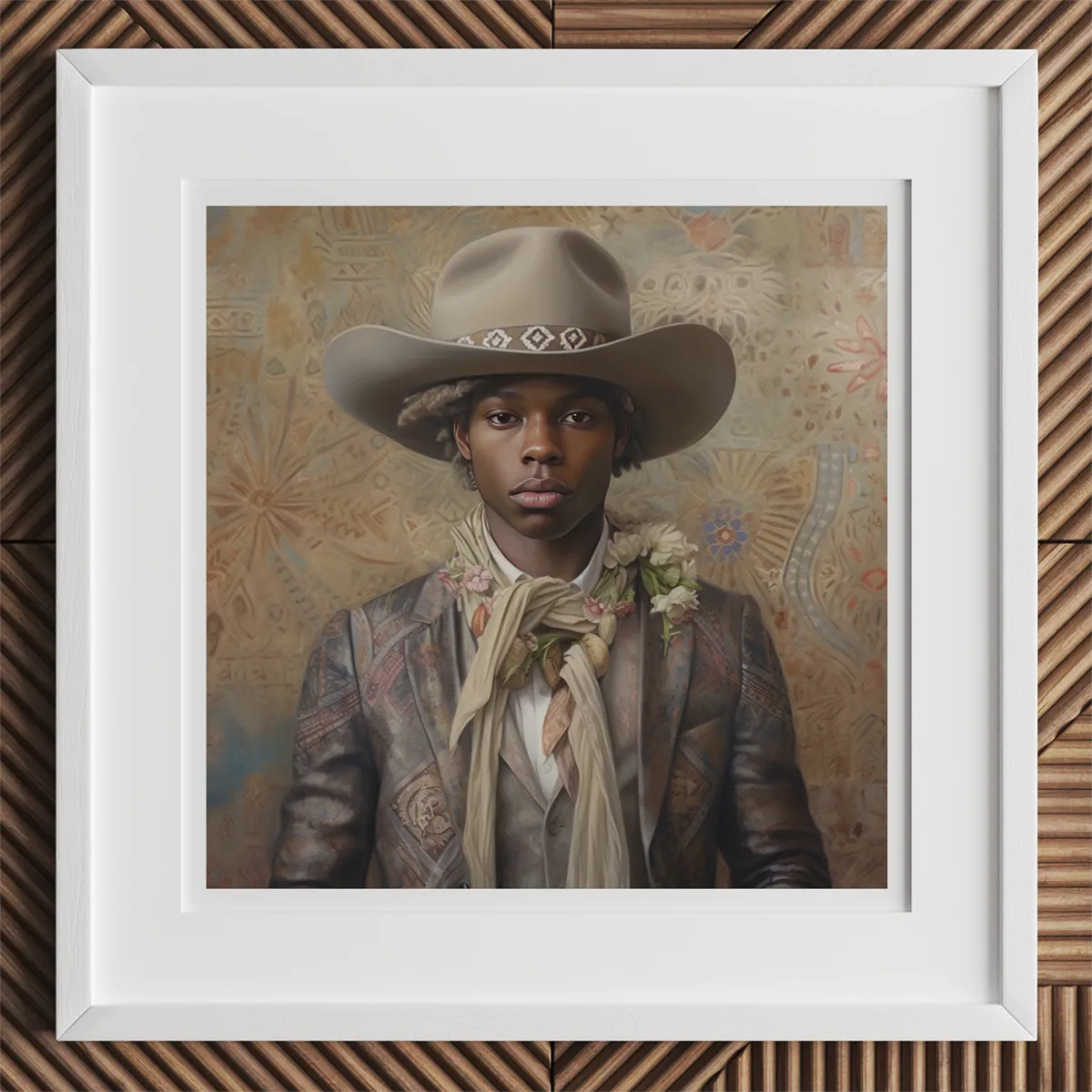
Reading List
Berger, Knute. Meet Nell Pickerell, Transgender At-Risk Youth of Yesteryear
Benemann, William. Men in Eden: William Drummond Stewart and Same-Sex Desire in the Rocky Mountain Fur Trade
Billington, Monroe Lee, and Roger D. Hardaway, eds. African Americans on the Western Frontier
Black Hills Visitor Magazine. Biography: Charles Badger Clark
Boag, Peter. Redressing ‘Cross-Dressers’ and Removing ‘Berdache'
Brown, Benjamin. Black Cowboys Played Major Role in Shaping the American West
Capozzi, Nicco. The Myth of the American Cowboy
Clark, Badger. Sun and Saddle Leather
Collins, Jan MacKell. Untold Tales of Gender-Nonconforming Men and Women of the Wild West
Cooper, James Fenimore. The Leatherstocking Tales
Durham, Philip, and Everett L. Jones. The Negro Cowboys
Garceau, Dee. “Nomads, Bunkies, Cross-Dressers, and Family Men: Cowboy Identity and the Gendering of Ranch Work.” — Across the Great Divide: Cultures of Manhood in the American West
Hardaway, Roger D. African American Cowboys on the Western Frontier
Hobsbawm, Eric. “The Myth of the Cowboy
Jessie Y. Sundstrom. Badger Clark, Cowboy Poet with Universal Appeal
The Journal of Blacks in Higher Education. Deadwood Dick and the Black Cowboys
Kinsey, Alfred C. Sexual Behavior in the Human Male
Lawrence, D. H. Studies in Classic American Literature
Miller, Hana Klempnauer. Out West: The Queer Sexuality of the American Cowboy and His Cultural Significance
Osborne, Russell. Journal of a Trapper; In the Rocky Mountains Between 1834 and 1843
Packard, Chris. Queer Cowboys: And Other Erotic Male Friendships in Nineteenth-Century American Literature
Patterson, Eric. On Brokeback Mountain: Meditations about Masculinity, Fear, and Love in the Story and the Film
Remington, Frederic. Late 19th-century cowboy articles; see Hobsbawm, “Myth of the Cowboy.”
Roosevelt, Theodore. Ranch Life and the Hunting-Trail
Slotkin, Richard. Myth and the Production of History. - Ideology and Classic American Literature
Turner, Frederick Jackson. The Frontier in American History
Vestal, Stanley. Jim Bridger; Mountain Man

